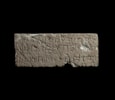Hasaean Funerary Stone for 'Matmat'
Hasaean Funerary Stone for 'Matmat'
South Arabian
5th - 4th Century B.C.
Limestone
H: 25.5 x W: 62 cm
Sold
Large funerary stone, inscribed in a Hasaean dialect using a variety of South Arabian monumental script, with three inscribed lines for the man Matmat, recording both patrilineal and matrilineal descent. Translated by Dr. A. Jamme, it reads: nfs/wqbr/mtmt/ 1: Tombstone and grave of Matmat, bn/zrbbt/’lt/’h/ 2: son of Zurubbat, those of ‘Ahns/ d’t/’b/s’d 3: nas, her of the father of Sa’ad- ‘b/ 4: ‘ab. The southern Arabian states organized the ancient trade routes which traversed the western coast of the Arabian Peninsula and the eastern expanses. A number of inscriptions have been discovered on the southern shores of the Arabian Gulf, mainly in Hasa’ province in Saudia Arabia, but also in southern Iraq. They are regarded as forming a distinct group because they are written in a variety of the Sabaean alphabet with some particular letter forms (D.T. Potts, he Arabian Gulf in Antiquity, Vol. II, From Alexander the Great to the Coming of Islam, Oxford, 990, pp. 69–85). To them can be added a few coins with the caption ‘Abiyatha’. The condition of these inscriptions, all on funerary stelae, is very poor: only a few words and proper names can be recognized (ibid., cat. 228). The article, used only with people’s names, is ‘han-’. Potts writes on page 379, “More importantly, however, over thirty inscriptions written in monumental South Arabian letters have been found at Thaj, Ayn Jawan, Qatif, Abqqaiq and al-Hinna [all near the Arabian gulf]. Typically, these inscriptions are funerary in character, appearing on grave stelae. Most of them follow the formula ‘memorial/ monument and tomb (nfs wqbr) [note the wording on the present inscription] of PN1 [personal name], son of PN2, of the group A, of the group B’”. Called ‘Hasaean’ or ‘Hasaitic’ after al-Hasa’, a traditional Arabic term for the Eastern Province of Saudi Arabia, the inscriptions could be “better described as ‘Hagaric’ because they were probably written by inhabitants of the kingdom of Hagar, better known by the Greek name of Gerrha” (ibid., p.122). Their language is not a South Arabian one but rather a dialect of ancient North Arabian. The names in these texts are Semitic. Although most of the Hasaitic inscriptions have been found out of context, one example of this type (CIH699), found interestingly enough at Uruk in southern Iraq, was discovered in 1857 by William Kennet Loftus standing at one end of a small burial chamber, the inscription facing inward. Abdullah S. Al-Saud (in Potts 1990, p. 399 ), writing about the site of Ayn Jawan, north-west of the Gulf of Tarut, not far from Bahrain, writes: “The site was discovered in 1943 before the end of the Second World War, when the Saudi Aramco company decided to convert the land next to the port of Ras Tanura into a quarry. In the course of the operation, the Aramco workmen found mysterious constructions buried under mounds of sand. In 1945 a fragment of an inscription in South Arabic was unearthed, revealing the presence of the tomb of a woman named Ghatham bint Oumrat ibn Tahiou.
A. Jamme, Sabean and Hasaean Inscriptions from Saudi Arabia, Istituto di Studi del Vicino Oriente, Università di Roma, 1966, p. 74, pl. XVII, Ja 1048
David Aaron Ltd, 2021, No. 6.
Online Corpus of the Inscriptions of Ancient North Arabia database, ref SHI 33 http://krcfm.orient.ox.ac.uk/fmi/webd/ociana
Originally discovered prior to 10 January 1962, most likely by Aramco workers, it was photographed at the company camp at Ras Tanura not far from Jawan, so it is possible it came from there (according to a letter, 1962, between Aramco employee James P. Mandaville and epigraphist Fr. Albert Jamme, which the 1966 publication refers to).
With Jeff Miller, of Museum Antiques Ltd, from at least 1978, who reputedly acquired this object from a dealer who had acquired it from the archaeologist in the US directly a number of years before.
Private Collection of Judith Jacoby, Virginia, USA, acquired from the above on 11 November 1978 (accompanied by purchase notes, cheque from 11 November 1978 and further correspondence with Fr. Jamme).
US art market.
ALR: S00150550.
James Mandaville, Jr. began to undertake epigraphic research as his pastime and forwarded many inscriptions found by Aramco colleagues to Father Albert Jamme (1916-2004), Epigraphist, Catholic University, Washington, D.C., an expert in ancient Semitic languages, and a leading researcher in reading, interpreting, and classifying ancient South Arabian inscriptions.










 Enquire
Enquire




